Hyundai Mobis Bundle
How did Hyundai Mobis Evolve into a Global Automotive Powerhouse?
Journey back in time to uncover the fascinating Hyundai Mobis SWOT Analysis, a pivotal player in the automotive world. Founded in 1977, this company's evolution mirrors the dynamic shifts within the Korean automotive industry and beyond. From its roots as Hyundai Precision Industry, it has become a global leader in automotive parts.
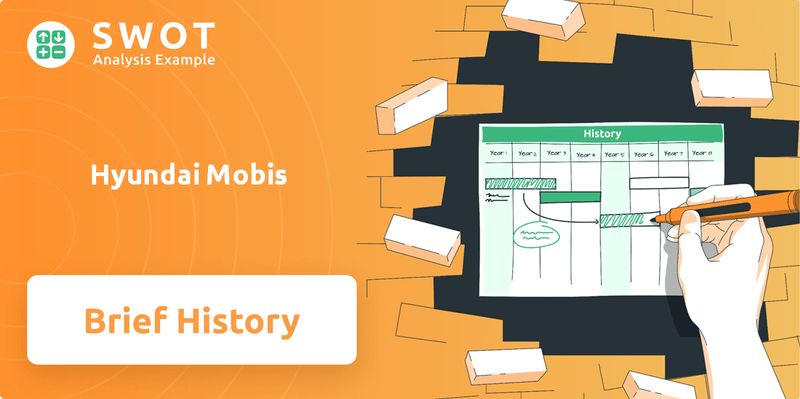
Understanding the Mobis history is crucial for grasping its current influence and future trajectory. This brief history of Hyundai Mobis explores its key milestones, from its early days supporting the Hyundai Group to its current status as a key enabler of future mobility solutions. Discover the Hyundai Mobis company background and its strategic investments in technological advancements, including autonomous driving and electrification, which have solidified its position in the global market.
What is the Hyundai Mobis Founding Story?
The story of Hyundai Mobis, a key player in the global automotive industry, began on July 1, 1977. Initially named Hyundai Precision Industry Co., Ltd., the company was established by the Hyundai Motor Group. This marked the start of what would become a significant force in the Korean automotive industry.
Chung Ju-yung, the founder of the Hyundai Group, was instrumental in its creation. His foresight led to the identification of a critical need within the rapidly growing automotive sector: a strong, integrated supply chain for automotive components. This strategic move was designed to reduce reliance on external suppliers and boost the efficiency of Hyundai Motor Company.
The initial focus of the company wasn't solely on automotive parts. It began by manufacturing a variety of precision industrial products, including containers and industrial machinery. However, the company quickly evolved, specializing in automotive components to support the growing needs of the Hyundai Motor Group.
Hyundai Mobis was founded in 1977 to create a robust supply chain for automotive components.
- The company initially produced industrial machinery and containers.
- The goal was to reduce reliance on external suppliers and boost efficiency.
- Chung Ju-yung, founder of the Hyundai Group, played a pivotal role.
- The context of rapid industrialization in South Korea influenced the company's creation.
The late 1970s in South Korea saw rapid industrialization and a strong push for self-sufficiency. This environment heavily influenced the company's formation. The aim was to internalize the production of essential automotive parts. This strategy was designed to enhance the competitiveness and operational control of the Hyundai Motor Group.
This strategic move aimed to reduce dependency on foreign imports and foster domestic technological capabilities within the automotive industry. The company's early focus on manufacturing various precision industrial products gradually shifted towards specializing in automotive parts. This specialization was a key step in supporting the growth of Hyundai Motor Company and the broader Korean automotive industry.
To learn more about the target market of Hyundai Mobis, you can read this article: Target Market of Hyundai Mobis. This will provide additional insights into the company's strategic focus.
Hyundai Mobis SWOT Analysis
- Complete SWOT Breakdown
- Fully Customizable
- Editable in Excel & Word
- Professional Formatting
- Investor-Ready Format
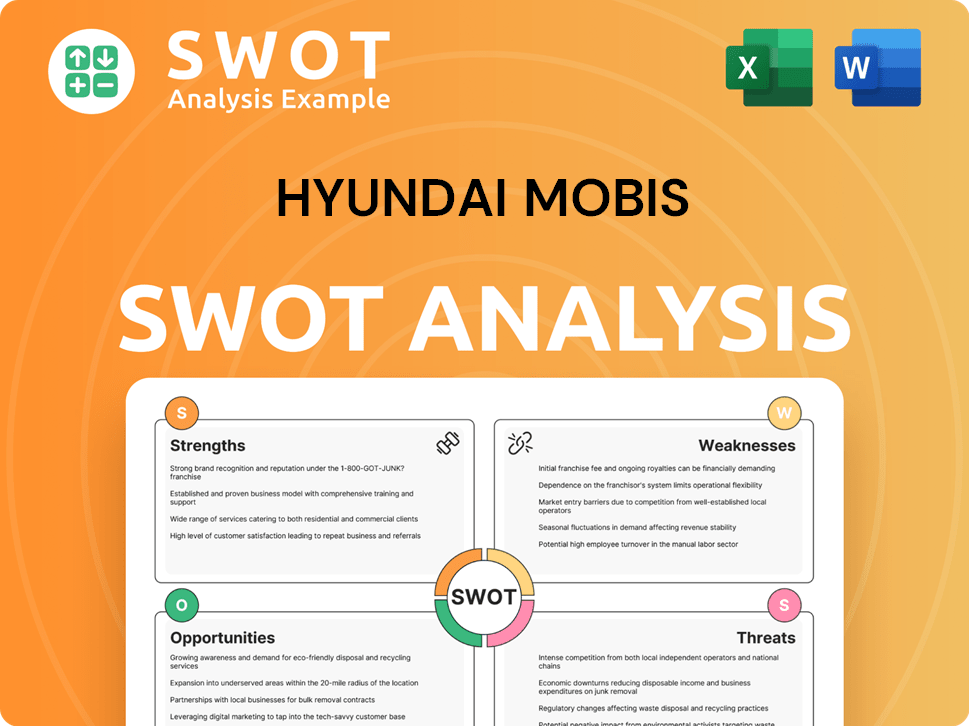
What Drove the Early Growth of Hyundai Mobis?
The early growth of Hyundai Mobis, formerly known as Hyundai Precision Industry, was significantly influenced by the success of Hyundai Motor Company. This period saw the expansion of its product range and the establishment of dedicated automotive parts manufacturing facilities. The company transitioned from a general manufacturer to a specialized automotive component supplier, laying the groundwork for its future growth. This is a brief history of Hyundai Mobis company.
Early product launches included chassis modules, cockpit modules, and front-end modules. These modules integrated multiple components into single units. This streamlined the assembly process for automakers, contributing to efficiency.
The company's growth was propelled by its role as a primary supplier to Hyundai and Kia Motors. This secured major sales milestones and solidified its position within the Hyundai Group's ecosystem. This close relationship was crucial for market share.
In 2000, Hyundai Precision Industry was renamed Hyundai Mobis, an acronym for 'Mobile and System.' This rebranding marked a pivot towards becoming a specialized automotive module and parts manufacturer. This aligned its identity more closely with its core business.
The company began establishing additional office and production facilities both domestically and internationally. This supported its expanding operations and catered to the global ambitions of its parent company. This expansion was key to its growth.
Hyundai Mobis PESTLE Analysis
- Covers All 6 PESTLE Categories
- No Research Needed – Save Hours of Work
- Built by Experts, Trusted by Consultants
- Instant Download, Ready to Use
- 100% Editable, Fully Customizable
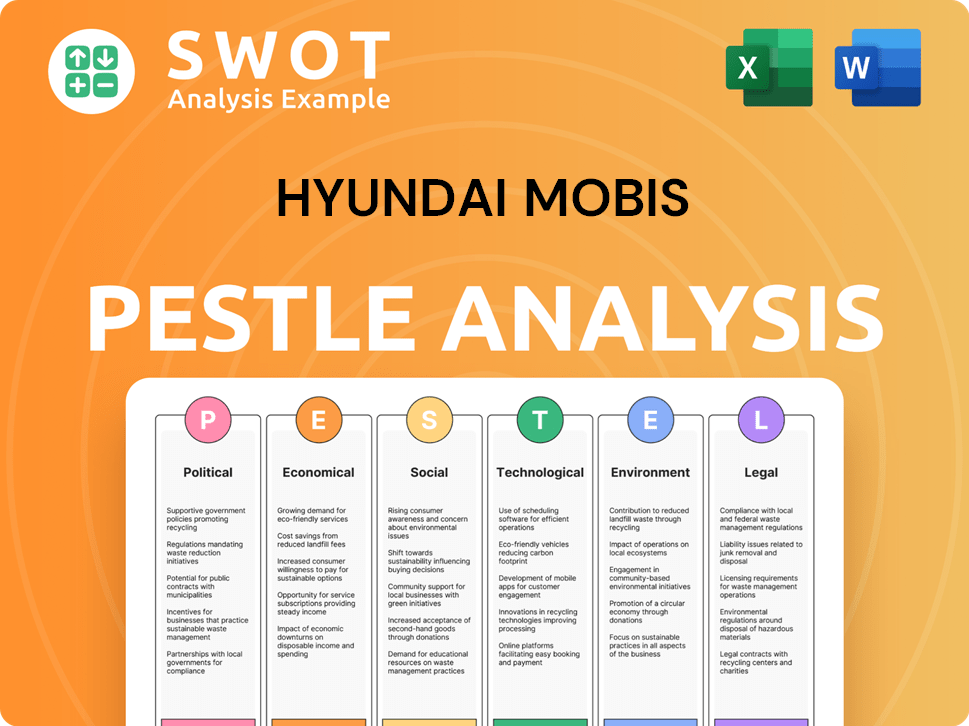
What are the key Milestones in Hyundai Mobis history?
The Hyundai Mobis company has achieved several significant milestones throughout its history, contributing substantially to the Korean automotive industry. This growth has been marked by strategic expansions and technological advancements, establishing Hyundai Mobis as a key player in the global automotive parts market. Its evolution reflects the dynamic changes within the automotive sector and the Hyundai Group's broader success.
| Year | Milestone |
|---|---|
| 1977 | Founded as Hyundai Precision & Industries Corporation, initially focusing on industrial machinery and equipment. |
| 1999 | Changed its name to Hyundai Mobis, marking a strategic shift towards becoming a major automotive parts supplier. |
| 2000s | Expanded its global presence with manufacturing facilities and R&D centers worldwide, including locations in North America, Europe, and Asia. |
| 2010s | Focused heavily on research and development, particularly in autonomous driving and electric vehicle (EV) components. |
| 2020s | Increased investments in future mobility technologies, including autonomous driving systems and EV components, to meet the growing demand for sustainable mobility. |
Hyundai Mobis has been at the forefront of innovation in the automotive parts sector. A groundbreaking advancement was the development and mass production of integrated automotive modules, which streamlined vehicle assembly for automakers. The company has also secured numerous patents in areas ranging from advanced braking systems to next-generation lighting technologies, showcasing its commitment to technological leadership.
Hyundai Mobis pioneered the development and mass production of integrated automotive modules. These modules, such as chassis and cockpit modules, combined multiple components into single pre-assembled units, significantly improving manufacturing efficiency.
The company has made significant strides in advanced braking systems, including electronic stability control (ESC) and anti-lock braking systems (ABS). These innovations enhance vehicle safety and performance.
Hyundai Mobis has invested heavily in developing advanced lighting technologies, such as LED and laser headlights. These innovations improve visibility and vehicle aesthetics.
Hyundai Mobis is actively developing autonomous driving technologies, including sensors, cameras, and software. The company aims to commercialize Level 4 autonomous driving systems in the coming years.
The company has expanded its electric vehicle (EV) component portfolio, including battery systems and power electronics. This expansion supports the growing demand for sustainable mobility solutions.
Hyundai Mobis is developing advanced connectivity solutions, including infotainment systems and vehicle-to-everything (V2X) technologies. These innovations enhance the driving experience and vehicle safety.
Despite its successes, Hyundai Mobis has faced several challenges. Market downturns, including global economic crises, have impacted automotive sales and, consequently, the demand for automotive parts. Competitive threats from established global suppliers and emerging technology firms have necessitated continuous innovation and strategic adaptation. For more insights into the company's marketing approach, consider exploring the Marketing Strategy of Hyundai Mobis.
Economic crises and fluctuations in the automotive market have occasionally led to decreased sales. These downturns require strategic adjustments to maintain profitability and market share.
Competition from established suppliers and new technology firms has driven the need for continuous innovation. This includes adapting to new technologies and market trends.
Developing complex automotive technologies involves significant investment and risk. Not all R&D projects proceed to mass production, requiring careful resource allocation.
Managing a global supply chain and ensuring timely delivery of components is a complex challenge. Disruptions can impact production schedules and costs.
Maintaining consistent quality across diverse manufacturing sites is crucial. Stringent quality control measures are necessary to meet industry standards.
Attracting and retaining skilled engineers and technicians is essential for innovation. Competition for talent in the automotive and technology sectors is fierce.
Hyundai Mobis Business Model Canvas
- Complete 9-Block Business Model Canvas
- Effortlessly Communicate Your Business Strategy
- Investor-Ready BMC Format
- 100% Editable and Customizable
- Clear and Structured Layout
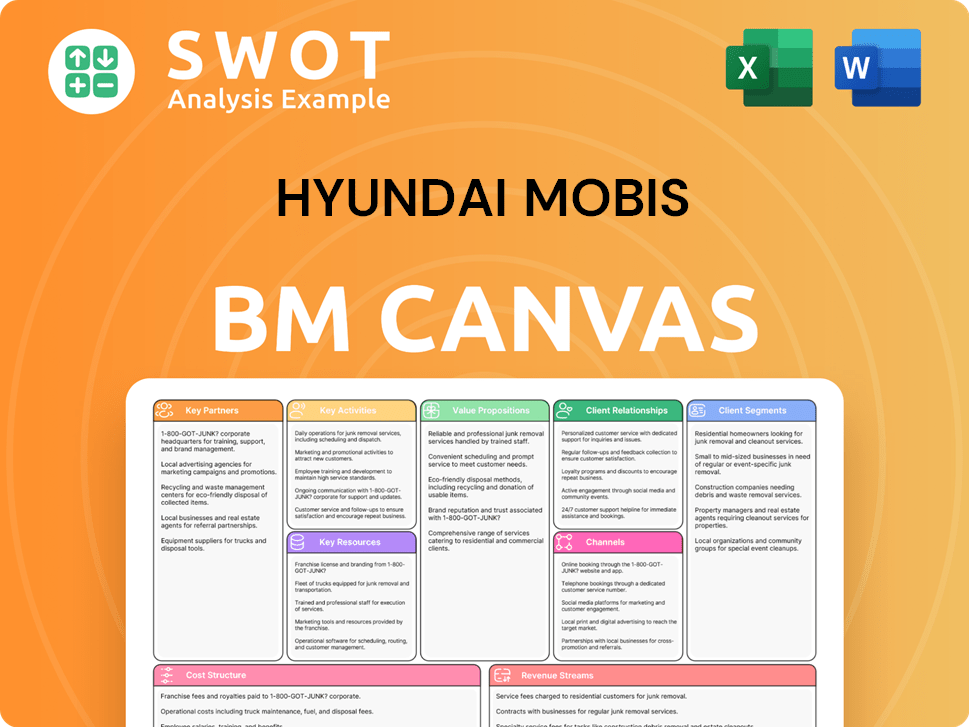
What is the Timeline of Key Events for Hyundai Mobis?
The Hyundai Mobis company has a rich history, evolving from a domestic automotive parts manufacturer to a global leader in automotive technology. Its journey is marked by strategic shifts, technological advancements, and significant investments in future mobility. This evolution showcases the company's adaptability and commitment to innovation within the Korean automotive industry and beyond, solidifying its position as a key player in the global automotive market.
| Year | Key Event |
|---|---|
| 1977 | Founded as Hyundai Precision Industry Co., Ltd., marking the beginning of its journey in the automotive sector. |
| 2000 | Renamed Hyundai Mobis, signaling a strategic shift towards automotive modules and components. |
| 2006 | Established its first overseas module factory in the United States, expanding its global footprint. |
| 2010 | Began developing advanced driver-assistance systems (ADAS) technologies, entering the realm of automotive technology. |
| 2013 | Completed its proving ground in Seosan, South Korea, for R&D and testing, enhancing its technological capabilities. |
| 2017 | Announced significant investments in future mobility technologies, including autonomous driving and electrification. |
| 2018 | Acquired the global lighting business of ZKW Group, expanding its lighting technology capabilities. |
| 2020 | Accelerated development of Level 4 autonomous driving technology and expanded its EV component portfolio. |
| 2024 | Continued focus on future mobility solutions, with ongoing R&D in software-defined vehicles and urban air mobility. |
| 2025 | Expected to further solidify its position as a key player in autonomous driving and electrification, with new product launches and strategic partnerships. |
Hyundai Mobis plans to expand its global presence, particularly in North America, Europe, and China. This expansion will involve localizing production and strengthening R&D capabilities in these regions. The company aims to increase its market share and strengthen its position in key automotive markets. For example, in 2024, the company invested significantly in expanding its manufacturing facilities in North America to meet growing demand.
The innovation roadmap focuses on advancing autonomous driving to higher levels, developing integrated platforms for software-defined vehicles, and expanding its electrification solutions. This includes hydrogen fuel cell systems and next-generation battery technologies. Hyundai Mobis is investing heavily in R&D to stay at the forefront of automotive innovation. Recent reports indicate substantial investments in autonomous driving technology, with the goal of achieving Level 4 autonomy in the near future.
Industry trends such as the shift towards electric vehicles, the rise of autonomous driving, and the increasing importance of software in vehicles are likely to significantly impact Hyundai Mobis's future. The company is well-positioned to capitalize on these trends. Analysts predict continued growth, driven by its strong relationship with the Hyundai Group and diversification efforts. You can explore the competitive landscape further in the Competitors Landscape of Hyundai Mobis.
Hyundai Mobis is committed to becoming a leading provider of integrated mobility solutions. The company aims to strengthen its competitiveness in core components while expanding its presence in next-generation mobility technologies. Leadership emphasizes sustainable growth and technological leadership. This forward-looking approach ties back to the founding vision of contributing to the advancement of the automotive industry. The company's strategic focus includes significant investments in sustainable technologies.
Hyundai Mobis Porter's Five Forces Analysis
- Covers All 5 Competitive Forces in Detail
- Structured for Consultants, Students, and Founders
- 100% Editable in Microsoft Word & Excel
- Instant Digital Download – Use Immediately
- Compatible with Mac & PC – Fully Unlocked
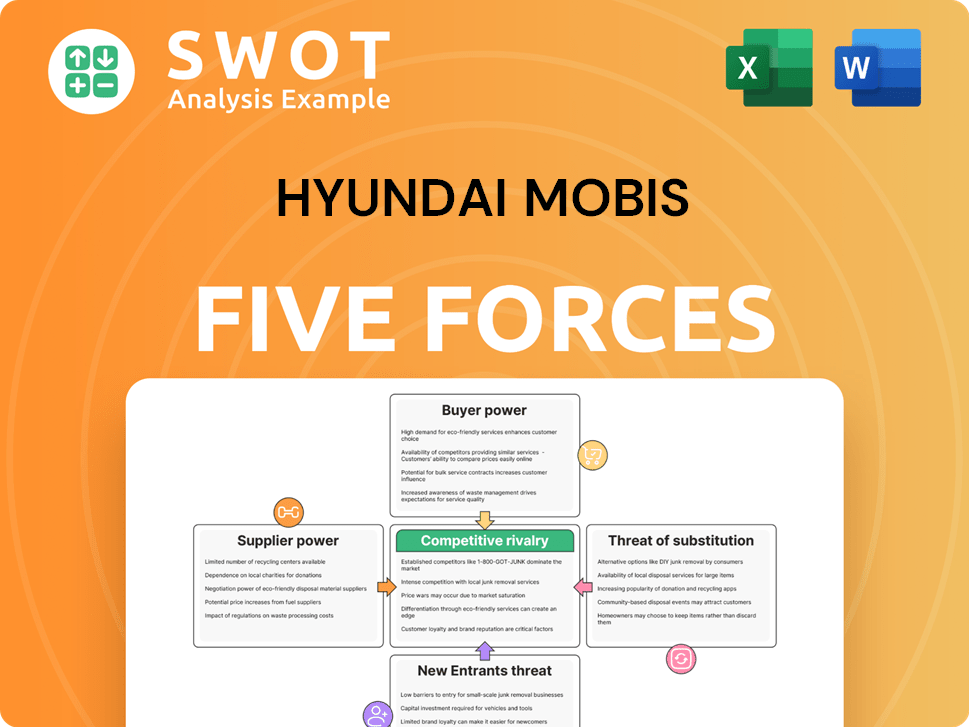
Related Blogs
- What is Competitive Landscape of Hyundai Mobis Company?
- What is Growth Strategy and Future Prospects of Hyundai Mobis Company?
- How Does Hyundai Mobis Company Work?
- What is Sales and Marketing Strategy of Hyundai Mobis Company?
- What is Brief History of Hyundai Mobis Company?
- Who Owns Hyundai Mobis Company?
- What is Customer Demographics and Target Market of Hyundai Mobis Company?
Disclaimer
All information, articles, and product details provided on this website are for general informational and educational purposes only. We do not claim any ownership over, nor do we intend to infringe upon, any trademarks, copyrights, logos, brand names, or other intellectual property mentioned or depicted on this site. Such intellectual property remains the property of its respective owners, and any references here are made solely for identification or informational purposes, without implying any affiliation, endorsement, or partnership.
We make no representations or warranties, express or implied, regarding the accuracy, completeness, or suitability of any content or products presented. Nothing on this website should be construed as legal, tax, investment, financial, medical, or other professional advice. In addition, no part of this site—including articles or product references—constitutes a solicitation, recommendation, endorsement, advertisement, or offer to buy or sell any securities, franchises, or other financial instruments, particularly in jurisdictions where such activity would be unlawful.
All content is of a general nature and may not address the specific circumstances of any individual or entity. It is not a substitute for professional advice or services. Any actions you take based on the information provided here are strictly at your own risk. You accept full responsibility for any decisions or outcomes arising from your use of this website and agree to release us from any liability in connection with your use of, or reliance upon, the content or products found herein.